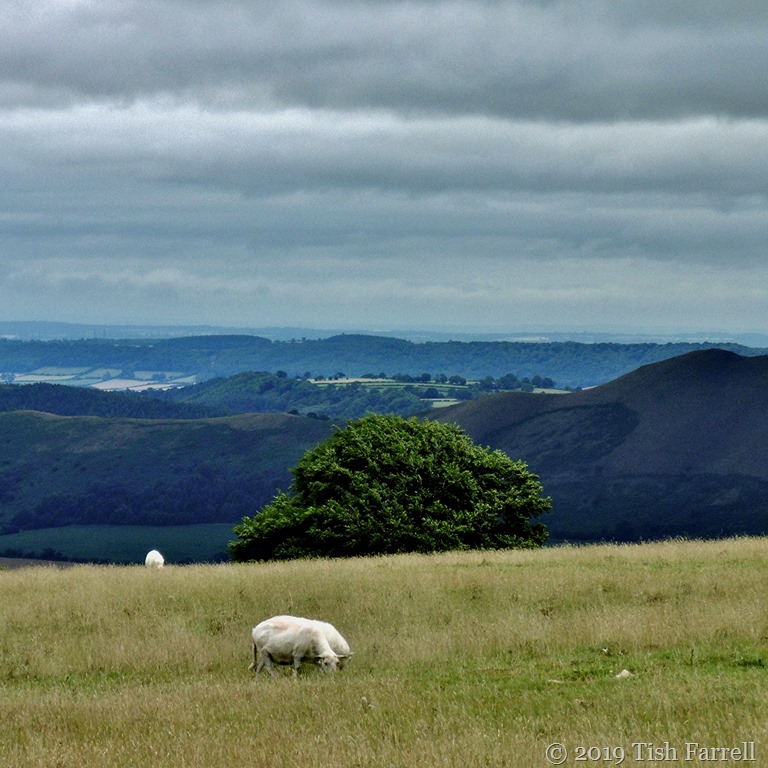Into my heart on air that kills
From yon far country blows:
What are those blue remembered hills,
What spires, what farms are those?
That is the land of lost content,
I see it shining plain,
The happy highways where I went
And cannot come again.
From A. E. Housman’s A Shropshire Lad 1896
*
We are lucky enough to live on the edge of Wenlock Edge whose ridge-top road delivers us straight to the heart of Shropshire’s hill country. Caer Caradoc, Lawley, Ragleth, Long Mynd, Stiperstones are some of the most well known of our uplands, each striking in its own way and often featuring in old tales and mysterious legends. This is not surprising considering that humans have been walking these lands for at least the last 9,000 years when the ice sheets retreated.
The whole area is rich in prehistoric remains – burial cairns, standing stones, hill forts, Bronze Age field systems, trackways, drove roads and trade routes. This photo was taken from the northerly flanks of the Long Mynd, on the lane to Ratlinghope and Bridges, and looks over the Lawley to the long blue-green spine of Wenlock Edge.



Lovely. Isn’t your title the title of Rosemary Sutcliff’s biography?
janet
Or at least the blue remembered hills bit.
It is, I discover, now you’ve mentioned it. She must have borrowed it from Housman. As did a few other people including playwright Dennis Potter.
Ah, I remember Ragleth, Long Mynd, Stiperstones….
love it when history, beauty and nature all come together. Wonderful post Tish xx
It’s not a bad part of the country 🙂
Do you miss it? I’m sure you have moments.
I certainly miss the ease of shopping in Ludlow. And that lovely market!
Can understand that!
Yes, nothing like it down here (that I have found). But I love being closer to the sea. I guess we never can ‘have it all’.
Yes, the sea would do it for me too. I often think I’m going to live beside it – as if it’s something I’ve planned. In fact that notion first took root when I was scarcely a teen, but staying at the hotel of a family friend in Mawgan Porth. Something to do with sand in sunbleached floor boards in a little cliffside villa.
I’d love to have a house where I could just open the door and walk out the gate down a sandy track and onto the beach. Sadly not going to happen now as those sort of houses are way too expensive.
That was exactly what I had in mind too 🙂
Perhaps we need to combine budgets! Or you need to write a best-seller!
As to to best seller writing – no pressure then! 😉
I’m sure if anyone can do it you can!
So nice you have such faith in me.
Well you are a true wordsmith along with Meg.
Full of wonderfulness Tish. The photo, the Housman quote, the prose. Thank you so much for this.
Happy you liked this, Hannah.
What a wonderful landscape, Tish. Lovely post. 🙂
Many thanks, Sylvia
Lovely photo Tish. I came late and circuitously to Housman via Potter’s unforgettable adults-as-children TV play.
Yes that Potter creation was v. memorable, and I think it’s interesting to view/come to Housman through that particular prism. He was v. angst-ridden. The seeming simplicity of the Shropshire Lad verses and their antique rhymes can make it too easy to underestimate him too. It’s amazing though in how many meaningful other quarters his words crop up – e.g. the scene of Finch Hatton’s burial in Out of Africa; the set-to-music versions of Vaughan Williams and Butterworth. Words as catalysts to others’ creativity.
I agree that the simplicity can be misleading.
I read a lot of the first poems thinking he was writing about WWI, then went back and realised they predated that war by 20 or so years. It’s not surprising the poems were so popular with soldiers then.
Definitely a catalyst for many others’ work.
Yes, I was surprised about the war references, and thought the same as you. Seems it was the Boer War loss of life that was concerning him.
Yes; and I guess Britain was busy all through the 19th century sending soldiers to subdue populations rebelling against its colonial might. Even here in NZ.
Indeed we were. And we’re still at it, though the ‘possessions’ aren’t so clear cut.
That’s true ☹️
Oh, to be striding along those paths, Tish! 🙂 🙂
You did some good striding in these parts, Jo and Mick. We should follow your example.
Tish, it seems you have stolen some of our blue. Our skies are these days just dull and greyish
Oh dear. Grey days in East Africa. I remember those too. Hope you are well over in Nairobi.
I am well in Nairobi. It’s quite cold though
I remember that coldness too. Actually is much like that here in Shropshire today. Grey skies. Rain. Good for the shamba though.
Beautifully framed. 😀
Many thanks, WW.
😀
I love that do much, Tish.
Thank you, Angela.
Your photo and description make me want to visit someday! Absolutely lovely!
Thank you.